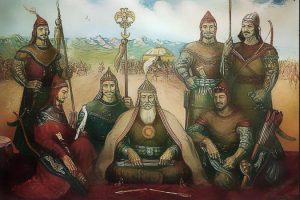
Early Life and Education: Leonardo da Vinci was the illegitimate son of Ser Piero and Caterina, born in the Tuscan hill town of Vinci. As a young boy, he displayed an insatiable curiosity and an innate talent for artistic pursuits. Recognizing his potential, his father apprenticed him to the renowned artist Andrea del Verrocchio in Florence. Under Verrocchio’s guidance, Leonardo honed his skills in painting, sculpture, and technical drawings.
Artistic Mastery: Leonardo’s artistic prowess was unparalleled. His masterpiece, the “Mona Lisa,” is perhaps the most famous painting in the world, known for its enigmatic smile. He also created iconic works such as “The Last Supper” and “The Vitruvian Man.” Leonardo’s artistic genius lay in his ability to bring vivid realism and emotional depth to his creations, revolutionizing the art of his time.
Scientific Exploration: Beyond art, Leonardo had a profound fascination with scientific inquiry. He made significant contributions to various fields, including anatomy, engineering, and physics. Through meticulous dissections, he gained deep insights into human anatomy, creating highly accurate anatomical drawings that are still revered today. His investigations into the movement of water, optics, and mechanics also laid the foundation for advancements in these disciplines.
Engineering Marvels: Leonardo’s engineering prowess was ahead of his time. He envisioned and designed revolutionary machines, many of which were never built but demonstrated his visionary thinking. His drawings included flying machines, tanks, and automated devices. Although they remained unrealized during his lifetime, these designs later inspired future inventors and engineers.
Inquisitive Mind and Notebooks: Leonardo’s insatiable curiosity and thirst for knowledge led him to maintain extensive notebooks filled with sketches, observations, and ideas. These notebooks, known as “codices,” provide a window into his mind and showcase his ability to bridge different disciplines. The most famous of these is the “Codex Leicester,” a collection of scientific writings and theories.
Legacy and Influence: Leonardo da Vinci’s impact on art and science cannot be overstated. He embodied the spirit of the Renaissance, with his commitment to exploration, innovation, and the pursuit of knowledge. His multidisciplinary approach serves as a model for modern interdisciplinary research. Artists and scientists continue to draw inspiration from his works, appreciating his technical precision and creative imagination.
Conclusion: Leonardo da Vinci, a true polymath of his time, left an indelible mark on the world. His artistic brilliance, scientific inquiry, and engineering prowess continue to captivate audiences centuries later. From his iconic paintings to his visionary designs, Leonardo’s contributions exemplify the spirit of human potential and the power of interdisciplinary exploration. He remains an eternal symbol of creativity, curiosity, and



















Add Comment